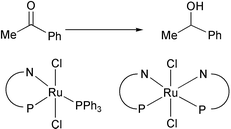Novel ruthenium(ii) complexes containing imino- or aminophosphineligands for catalytic transfer hydrogenation
Abstract
Five- and six-coordinate ruthenium(II) complexes containing ![[double bond, length as m-dash]](https://www.rsc.org/images/entities/char_e001.gif) NR (R = Ph (1a); 2′,6′-C6H3Me2
(1b); 2′-C6H4OMe (1c)) lead to the chelate iminophosphine complexes [RuCl2(κ2-P,N-2-Ph2PC6H4CH
NR (R = Ph (1a); 2′,6′-C6H3Me2
(1b); 2′-C6H4OMe (1c)) lead to the chelate iminophosphine complexes [RuCl2(κ2-P,N-2-Ph2PC6H4CH![[double bond, length as m-dash]](https://www.rsc.org/images/entities/char_e001.gif) NR)(PPh3)]
(R = Ph (3a); 2′,6′-C6H3Me2
(3b)) and [RuCl2(κ3-P,N,O-2-Ph2PC6H4CH
NR)(PPh3)]
(R = Ph (3a); 2′,6′-C6H3Me2
(3b)) and [RuCl2(κ3-P,N,O-2-Ph2PC6H4CH![[double bond, length as m-dash]](https://www.rsc.org/images/entities/char_e001.gif) N-2′-C6H4OMe)(PPh3)]
(3c), respectively. Similarly, reactions with
N-2′-C6H4OMe)(PPh3)]
(3c), respectively. Similarly, reactions with ![[double bond, length as m-dash]](https://www.rsc.org/images/entities/char_e001.gif) NR (R = iPr (1d); (S)-CHMeCy (1e)) react with [RuCl2(DMSO)4] to lead to the bis-iminophosphine complexes [RuCl2(κ2-P,N-2-Ph2PC6H4CH
NR (R = iPr (1d); (S)-CHMeCy (1e)) react with [RuCl2(DMSO)4] to lead to the bis-iminophosphine complexes [RuCl2(κ2-P,N-2-Ph2PC6H4CH![[double bond, length as m-dash]](https://www.rsc.org/images/entities/char_e001.gif) NR)2]
(R = iPr (4d); (S)-CHMeCy (4e)). The crystal structure of 4d has been determined by X-ray diffraction. Complexes 3a–c, 4d,e and 5a,d,e are active in catalytic transfer hydrogenation of
NR)2]
(R = iPr (4d); (S)-CHMeCy (4e)). The crystal structure of 4d has been determined by X-ray diffraction. Complexes 3a–c, 4d,e and 5a,d,e are active in catalytic transfer hydrogenation of


 Please wait while we load your content...
Please wait while we load your content...